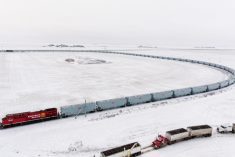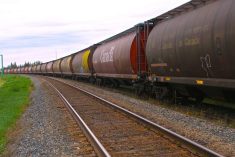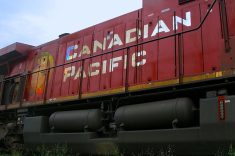Canadian Pacific Railway (CP) says it hopes to unclog one of the most infamous rail traffic bottlenecks in the U.S. with a bid to buy railway Norfolk Southern.
Confirming a recent news report on its plans, CP announced Tuesday it has sent an offer letter to Virginia-based NS.
The Calgary company didn’t disclose any financial details of its offer Tuesday, other than to say its cash-and-stock bid will amount to “a sizeable premium” for NS shareholders.
Read Also

Feed Grain Weekly: Prices levelling as demand wanes
Soft demand has feed grain prices levelling off, said Darcy Haley, vice-president of Ag Value Brokers in Lethbridge, Alta.
NS, however, appeared underwhelmed in its initial response later Tuesday, in which it revealed CP’s “unsolicited, low-premium, non-binding, highly conditional indication of interest” to be US$46.72 (C$62.23) cash plus 0.348 CP shares per NS share.
In all, NS said Tuesday, CP’s proposal is for a premium of “less than 10 per cent” based on its stock price at Tuesday’s close.
For grain shippers and other rail customers, however, CP bills its proposal as a major game-changer for the freight business in the U.S. Midwest and points east and south.
The offer proposes a “new approach to terminal access,” through which if a combined CP/NS “failed to provide adequate service or competitive rates,” it would allow another rail carrier with connections to the merged company’s tracks to run on CP/NS track and into CP/NS terminals.
CP said later Tuesday it’s still in the early stages of determining how it would define “adequate” or “competitive” in such cases — for example, through the use of service benchmarks or historic averages. It said, however, that such running rights would be an “unprecedented alternative” for a shipper.
CP also said shippers would get the choice of where they connect with another railroad along the combined CP/NS network. That, in turn, would mean “an end to the practice of ‘bottleneck pricing'” for a “large number” of U.S. shippers, CP said.
Furthermore, CP said, such a merger would spell relief for rail congestion in and around Chicago, which “seized into gridlock” in the winter of 2014.
“By channeling rail traffic away from Chicago, CP would create fluid routes through under-utilized hubs and free up much-needed capacity for other railroads that pass through the city,” CP said.
“In short, a combined CP/NS would create capacity for all shippers without creating the need for more infrastructure.”
Improving end-to-end rail freight would also cut down on highway truck traffic and “allow the rail industry to play an even greater role in the revival and sustained recovery of the North American economy,” CP said.
From a financial standpoint, CP said, a merged CP/NS would have “potential for faster earnings growth than either CP or NS could achieve on their own, all the while maintaining a strong investment-grade credit rating.”
The concessions offered on rail service and rates would also satisfy the U.S. Surface Transportation Board and Canadian regulators, CP said.
NS, in its release Tuesday, said its board and advisors will “carefully evaluate and consider (CP’s) indication of interest in the context of (NS’s) strategic plans.”
But NS also cautioned in its release Tuesday that any such consolidation among North America’s Class I railroads can expect to face “significant regulatory hurdles.”
The NS track network includes about 32,000 route km in the eastern and midwestern U.S., covering 22 states and the District of Columbia, running as far west as Des Moines, Kansas City and Shreveport and south to New Orleans and Jacksonville.
CP’s network, meanwhile, runs over 22,500 route km across Canada and south to Minneapolis, Chicago, Milwaukee, Kansas City and Albany, N.Y., through its ownership of the former Soo Line and Delaware and Hudson (D+H) Railway. — AGCanada.com Network
















